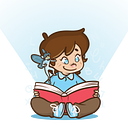SARA’s Books
SARA’s Books LLC is a company founded by Russ Fugal that’s dedicated to making reading a fun and enjoyable experience for everyone by focusing on fluency and using technology to help emerging readers develop their sight word vocabulary.

We are developing an e-reader app powered by SARA’s assessment and recommendation algorithms (SARA). SARA is optimized for fluency and ranks and promotes content that matches a reader’s personal fluency and interests. The goal is to help close the literacy gap and get kids excited about reading.

But, as with any new technology, there are challenges. One of the biggest is demonstrating that this new approach is just as effective, if not more so, than intensive phonics-based instruction. After years of trying to put together an effective study on a $0 budget, SARA’s Books just submitted a grant proposal to America’s Seed Fund, powered by the National Science Foundation, to overcome the technical hurdles and show that the innovation of this e-reader app is the way of the future.

If all goes well, the commercialization of this app could have a big impact on the world. A more literate population means a stronger economy, better health outcomes, and increased engagement with science and technology. Plus, it could help a whole new generation of kids fall in love with reading!
What we’re focused on
Without fluency, reading is not enjoyable. Fluent reading surfaces courage within emerging readers; courage to read more and to read often. Fluent readers better comprehend and remember the texts they read. They become more avid readers, they identify as strong readers, and they become better learners.
Getting to fluency, however, is easier said than done as even the best instruction suffers a wide efficacy gap. In fourth grade, one in three readers are below even basic levels of literacy, only one in three are proficient, and fewer than one in ten are advanced. This literacy gap exists within schools and even classrooms, and often even between siblings.
Viewing print exposure as a proxy measure for fluency (which is supported by a 2018 study of over 11,000 identical and fraternal twins from the Netherlands born between 1994 and 2004; van Bergen et al.), data charted here from a 1988 study by Richard Anderson et al. shows just how big of a gap exists.

Anderson studied the reading habits of 155 fifth-grade students in Illinois. Students in the 70th percentile and above read twice as much or more as students in the 50th percentile and below. Print exposure drops off rapidly between the highest and lowest percentiles, with a 46-fold difference between the 90th and 10th percentiles
There has been a lot of unsuccessful effort over the years to close the literacy gap. We’re taking a new approach, focusing on the word-learning aspect of literacy and helping students learn unfamiliar words through the use of computer-aided reading.

This innovative approach presents both risks and opportunities. On one hand, there’s the technical risk of quantifying the efficacy of the aided reading method and demonstrating its effectiveness compared to traditional phonics-based instruction. On the other hand, there’s the opportunity to revolutionize the way students learn to read, by providing a more personalized and efficient approach that considers each student’s individual fluency. So, I hope you follow our story at SARA’s Books.
If you’d like to do more than follow along, get involved at Sara.ai/startup.html
